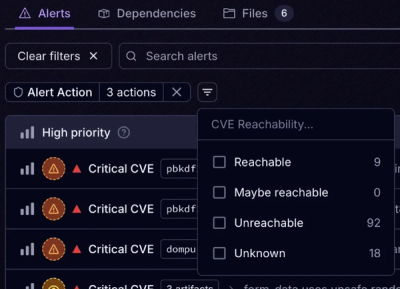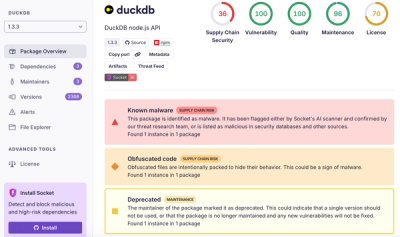
Product
Introducing Tier 1 Reachability: Precision CVE Triage for Enterprise Teams
Socket’s new Tier 1 Reachability filters out up to 80% of irrelevant CVEs, so security teams can focus on the vulnerabilities that matter.
The right_api_client gem simplifies the use of RightScale's MultiCloud API. It provides a simple object model of the API resources, and handles all of the fine details involved in making HTTP calls and translating their responses. It is assumed that users are already familiar with the RightScale API:
Maintained by the RightScale QA ServerTemplate and Ivory Automation Team
Ruby 2.0 or higher is required as of version 1.6
gem install right_api_client
New users can start with the following few lines of code and navigate their way around the API by following the available methods. You can find your account id by logging into the RightScale dashboard (https://my.rightscale.com), navigate to the Settings > Account Settings page. The account is is at the end of the browser address bar.
require 'right_api_client'
@client = RightApi::Client.new(:email => 'my@email.com', :password => 'my_password', :account_id => 'my_account_id')
puts "Available methods: #{@client.api_methods}"
The client makes working with and getting to know the API much easier. It spiders the API dynamically to
discover its resources on the fly. At every step, the user has the ability to query api_methods(), which
indicates the potential methods that can be called. The config/login.yml.example file provides
details of different login parameters, for example, oauth authentication.
Essentially, just follow the RightScale API documentation (available from http://support.rightscale.com) and treat every resource in the paths as objects that can call other objects using the dot (.) operator:
Examples:
# Index datacenters: GET /api/clouds/:cloud_id/datacenters
@client.clouds(:id => 1).show.datacenters.index
# Show server: GET /api/clouds/:cloud_id/datacenters/:id
@client.clouds(:id => 1).show.datacenters(:id => 2).show
# Create server: POST /api/deployments/:deployment_id/servers
@client.deployments(:id => 3).show.servers.create
# Update server: PUT /api/deployments/:deployment_id/servers/:id
@client.deployments(:id => 3).show.servers(:id => 4).update
# Destroy server: DELETE /api/deployments/:deployment_id/servers/:id
@client.deployments(:id => 3).show.servers(:id => 4).destroy
# A non-CRUD action: POST /api/servers/:server_id/launch
@client.servers(:id => 4).show.launch
# Get an resource by it's href
@client.resource('/api/clouds/1/volumes/bfd53dbc005f').show
As seen above, whenever you need to chain methods, you must call .show before specifying the next method.
You can inspect all the information about the last HTTP request, including its response. For more info: https://github.com/rest-client/rest-client
Examples:
deployments = @client.deployments.index
last_request = @client.last_request[:request]
last_url = last_request.url
last_method = last_request.method
last_response = @client.last_request[:response]
last_code = last_response.code
last_headers = last_request.headers
Pass-in parameters to the method that they belong to. Lets say you want to filter on the index for deployments:
@client.deployments.index(:filter => ['name==my_deployment'])
The filter is the parameter for the index call and not the deployment call.
The HTTP calls made by right_api_client can be logged in two ways.
Log to a file:
@client.log('~/right_api_client.log')
Log to STDOUT:
@client.log(STDOUT)
HTTP calls can sometimes fail. To enable retrying idempotent requests automatically, enable the :enable_retry flag. By default, this value is false
@client = RightApi::Client.new(:email => 'my@email.com', :password => 'my_password', :account_id => 'my_account_id', :enable_retry => true)
Multiple accounts can be managed by using the api_url and account_id attributes on the client.
The api_url attribute allows users to modify the shard which the client is being used to connect to. This should not be required as the client will find the correct shard using the account id (except when using a refresh_token for authorization; in this case api_url must be set to your shard address).
Example:
@client.api_url # https://my.rightscale.com
@client.api_url = 'https://us-3.rightscale.com' # Update the client to make requests to shard 3
The account_id switches which account is being managed by the client. This allows a user with multiple accounts to perform actions whilst only having to authenticate once. This defaults to the account which was used to create the client.
Example:
@client.account_id = 1
@client.users.index.count # The number of users in account with id 1
@client.account_id = 2
@client.users.index.count # The number of users in account with id 2
Get a list of all servers (aka doing an Index call)
@client.servers.index
Get a list of all servers in a deployment
@client.deployments(:id => 'my_deployment_id').show.servers.index
Get a particular server (aka doing a Show call)
@client.servers(:id => 'my_server_id').show
Creating a server involves setting up the required parameters, then calling the create method
server_template_href = @client.server_templates.index(:filter => ['name==Base ServerTemplate']).first.href
cloud = @client.clouds(:id => 'my_cloud_id').show
params = { :server => {
:name => 'Test Server',
:deployment_href => @client.deployments(:id => 'my_deployment_id').show.href,
:instance => {
:server_template_href => server_template_href,
:cloud_href => cloud.href,
:security_group_hrefs => [cloud.security_groups.index(:filter => ['name==default']).first.href],
:ssh_key_href => cloud.ssh_keys.index.first.href,
:datacenter_href => cloud.datacenters.index.first.href
}}}
new_server = @client.servers.create(params)
new_server.api_methods
Launch the newly created server. Inputs are a bit tricky so they have to be set in a long string
inputs = "inputs[][name]=NAME1&inputs[][value]=text:VALUE1&inputs[][name]=NAME2&inputs[][value]=text:VALUE2"
new_server.show.launch(inputs)
Run a script on the server. The API does not currently expose right_scripts, hence, the script href has to be retrieved from the dashboard and put in the following href format.
script_href = "right_script_href=/api/right_scripts/382371"
task = new_server.show.current_instance.show.run_executable(script_href + "&inputs[][name]=TEST_NAME&inputs[][value]=text:VALUE1")
task.show.api_methods
Update the server's name
params = { :server => {:name => 'New Server Name'}}
@client.servers(:id => 'my_server_id').update(params)
Terminate the server (i.e. shutdown its current_instance)
@client.servers(:id => 'my_server_id').show.terminate
Destroy the server (i.e. delete it)
@client.servers(:id => 'my_server_id').destroy
The client returns 3 types of objects:
client.deployments@client.deployments(:id => :deployment_id)
@client.deployments.index@client.deployments(:id => deployment_id).showclient.deployments(:id => deployment_id).showOn all 3 types of objects you can query .api_methods to see a list of available methods, e.g.: client.deployments.api_methods
inputs.index will return an array of ResourceDetail objects since you cannot do a .show on an inputsession.index will return a ResourceDetail object since you cannot do a .show on a sessiontags.by_resource, tags.by_tag will return an array of ResourceDetail objects since you cannot do a .show on a resource_tagmonitoring_metrics(:id => :m_m_id).show.data will return a ResourceDetail object since you cannot do
a .show on a monitoring_metric_dataThe client also supports 'instance facing calls', which use the instance_token to login. Unlike regular email-password logins, instance-facing-calls are limited in the amount of allowable calls. Since in most of the cases, the calls are scoped to the instance's cloud (or the instance itself), the cloud_id and the instance_id will be automatically recorded by the client, so that the user does not need to specify it.
@instance_client = RightApi::Client.new(:instance_token => 'my_token', :account_id => 'my_account_id')
@instance_client.volume_attachments links to /api/clouds/:cloud_id/volume_attachments
@instance_client.volumes_snapshots links to /api/clouds/:cloud_id/volumes_snapshots
@instance_client.volumes_types links to /api/clouds/:cloud_id/volumes_types
@instance_client.volumes links to /api/clouds/:cloud_id/volumes
@instance_client.backups links to /api/backups
@instance_client.live_tasks(:id) links to /api/clouds/:cloud_id/instances/:instance_id/live/tasks/:id
For volume_attachments and volumes_snapshots you can also go through the volume:
@instance_client.volumes(:id => :volume_id).show.volume_attachments
which maps to:
/api/clouds/:cloud_id/volumes/:volume_id/volume_attachment
The instance's volume_attachments can be accessed using:
@instance_client.get_instance.volume_attachments
which maps to:
/api/clouds/:cloud_id/instances/:instance_id/volume_attachments
Because the cloud_id and the instance_id are automatically added by the client, scripts that work for regular
email-password logins will have to be modified for instance-facing calls. The main reason behind this is the
inability for instance-facing calls to access the clouds resource (i.e.: @instance_client.clouds(:id=> :cloud_id).show will fail)
When you query api_methods, it will list all of the methods that one sees with regular email-password logins.
Due to the limiting scope of the instance-facing calls, only a subset of these methods can be called
(see the API Reference Docs for valid methods). If you call a method that instance's are not authorized to access,
you will get a 403 Permission Denied error.
Having RightLink10 installed on an instance allows 'instance facing calls' via a local proxy. To use the proxy on the instance, you will only need to provide the following parameter:
:rl10 Set this to trueSetting this parameter to true will use the information in the proxy authentication file to create the client.
@instance_client = RightApi::Client.new(:rl10 => true)
In the code, we only hard-code CRUD operations for resources. We use the .show and .index methods to make the client more efficient. Since it dynamically creates methods it needs to query the API at times. The .show and the .index make it explicit that querying needs to take place. Without them a GET would have to be queried every step of the way (i.e.: the index call would be client.deployments, and the create call would be client.deployments.create which would first do an index call).
In general, when a new API resource is added, you need to indicate in the client whether index, show, create, update and delete methods are allowed for that resource.
Put these special cases in the RightApi::Helper::INCONSISTENT_RESOURCE_TYPES hash.
Put these special cases in the RightApi::Helper::RESOURCE_TYPE_SPECIAL_ACTIONS hash.
bundle exec rspec spec/unit
See Usage Instructions for how to configure functional testing.
bundle exec rspec spec/functional
To avoid this message you can set :timeout when creating your RightAp::Client object. You will need
to use a different value depending on which version of rest-client is being used.
:timeout => nil, infinite timeout - no warning message.:timeout => -1, infinite timeout - plus the error message above being displayed.FAQs
Unknown package
We found that right_api_client demonstrated a not healthy version release cadence and project activity because the last version was released a year ago. It has 2 open source maintainers collaborating on the project.
Did you know?

Socket for GitHub automatically highlights issues in each pull request and monitors the health of all your open source dependencies. Discover the contents of your packages and block harmful activity before you install or update your dependencies.

Product
Socket’s new Tier 1 Reachability filters out up to 80% of irrelevant CVEs, so security teams can focus on the vulnerabilities that matter.

Research
/Security News
Ongoing npm supply chain attack spreads to DuckDB: multiple packages compromised with the same wallet-drainer malware.

Security News
The MCP Steering Committee has launched the official MCP Registry in preview, a central hub for discovering and publishing MCP servers.